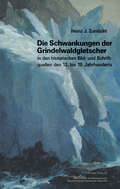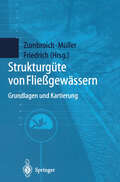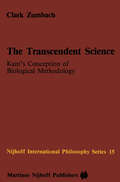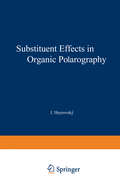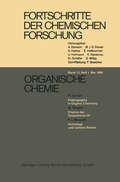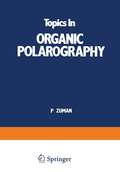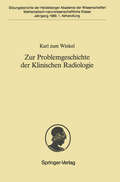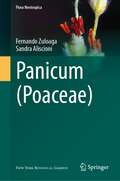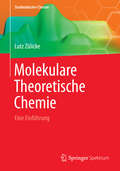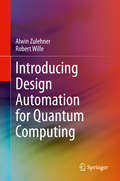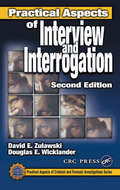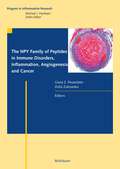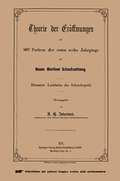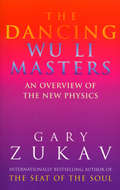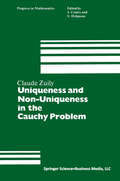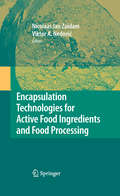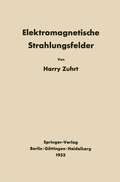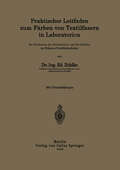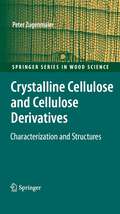- Table View
- List View
Die Schwankungen der Grindelwaldgletscher in den historischen Bild- und Schriftquellen des 12. bis 19. Jahrhunderts: Ein Beitrag zur Gletschergeschichte und Erforschung des Alpenraumes (Denkschriften der schweizerischen Naturforschenden Gesellschaft)
by ZUMBÜHLStrukturgüte von Fließgewässern: Grundlagen und Kartierung
by Thomas Zumbroich Andreas Müller Günther FriedrichThe Transcendent Science: Kant’s Conception of Biological Methodology (Nijhoff International Philosophy Series #15)
by C. ZumbachThe most neglected sector of Kant's Critical Philosophy is his collec tion of remarks about biological phenomena in the second part of the Critique of Judgment, the Critique of Teleological Judgment. The reasons for this are numerous, but since in Kant, everything comes in threes, a three-fold collection will suffice. The Critique of Teleological Judgment itself is one reason. More than most of his writings, this segment of the Critical corpus suffers from what can most charitably be termed "mistakes of exposition. " In this part of the third Critique, it is commonplace to find sub-arguments in Kant's general position somewhere other than their logical niche. The result is that the general theme behind his remarks about living phenomena is obscured. This difficulty has done much to discourage even the most enthusiastic of Kant admirers from investing their time on this work. Secondly, in this century, until very recently, there has been little interest in philosophical questions about biology. Twenty-one out of thirty-one sections of the Critique of Teleological Judgment (sections #61 and 63-83) deal either directly or indirectly with issues of interest in the philosophy of biology. Finally, the Critique of Teleological Judgment has been placed among the last on that list "of writings thought to formulate Kant's Critical system. This is not merely because of its temporal position.
Substituent Effects in Organic Polarography
by Petr ZumanDuring the forty years which have passed since Masuzo Shikata published his paper on the reduction of nitrobenzene at a dropping mercury electrode, the number of polarographic studies of organic compounds in the literature has risen to several thousands. The ever increasing amount of experimental data was in need of some unified method of classification which would yield unambiguous and possibly complete information on the polarographic behavior of organic substances. Dr. Zuman's book presents an original attempt to meet this need by providing a system based on correlations between the polaro graphic half-wave potentials of organic depolarizers and their Hammett constants. I consider this a very happy conception, for, more than any other book yet written, it brings polarography nearer to the organic chemist; and it will undoubtedly convince him that, in its application to his subject, the method is more than a mere analytical tool. The author hardly needs any introduction. During many years of research in the field of organic polarography, he has published numerous papers on a variety of problems; his latest interest is the application of the Hammett-Taft equation to polarographic measure ments, in which he has done pioneering work. It remains for me to hope that this book, which opens up new prospects for the fruitful application of polarography, may inspire vii viii Foreword some reader with useful ideas in his search for new paths in his research problems.
Organische Chemie (Topics in Current Chemistry #12/1)
by P. Zuman W. Steglich F. L. BreuschOrganische Chemie
Topics In Organic Polarography
by P. ZumanEven though the nwnber of requests for reprints and the number of quotations in the Science Citation Index has indicated an ever-increasing interest in topics of organic polarography, I have often felt that the reason that some work is less known may well be because the papers were published in less accessible journals. Therefore, I was pleased when I was asked to prepare a selection of my papers on organic polarography for reprinting. This collection of papers may indicate some of the possibilities offered by polarography in the study of properties of organic compounds. The fact that the papers are published in one volume, not only makes the information more easily accessible for the reader, but also enables a direct comparison of related topics. The mode of selection is discussed in the Introduction. The papers reprinted in this volume are mostly based on work carried out in the J. Heyrovsky Institute of Polarography of the Czechoslovak Academy of Sciences in Prague, in cooperation with my co-workers. I would like to take this opportunity of thanking all of them for the pleasure I got from this cooperation on the solution of varying problems of organic electrochemistry .
Zur Problemgeschichte der Klinischen Radiologie (Sitzungsberichte der Heidelberger Akademie der Wissenschaften #1989 / 1)
by Karl Zum WinkelDer methodische Wandel der klinischen Radiologie führte zur Verselbständigung von Radiodiagnostik, Radioonkologie und Nuklearmedizin, die als anerkannte Fachgebiete in der radiologischen Klinik oder im radiologischen Zentrum der Universität zusammenarbeiten. Entwicklung und Fortschritte einer stimulierenden, verständnisvollen Zusammenarbeit von Medizinern, Naturwissenschaftlern und Technikern werden am Beispiel der klinischen Radiologie geschildert. Die klinische Radiologie bleibt übergreifende Institution und ist deshalb mit einer Problematik konfrontiert, die sich durch definierte Aufgaben überwinden läßt, unter denen Kooperation und Integration sowie die humanitären und wissenschaftlichen Prinzipien der Universitätsmedizin eingehend diskutiert werden. Das Buch vermittelt einen hervorragenden Überblick über die Entwicklung des Faches "Klinische Radiologie", ohne das eine moderne Medizin undenkbar ist.
Panicum (Flora Neotropica #124)
by Fernando Zuloaga Sandra AliscioniThis work will be volume 124 in the Flora Neotropica Monograph book Series, Lawrence M. Kelly (Editor-in-Chief). Flora Neotropica volumes provide taxonomic treatments of plant groups or families growing in the Americas between the Tropic of Cancer and the Tropic of Capricorn. This monograph on Panicum (Poaceae), known as panicgrass, was written by the world-leading authority on this plant group. A total of one genus and 63 species are described. It also includes information on conservation, phylogenetic relationships, taxonomic history, ecology, cytology, and anatomy, among other topics. This is the first comprehensive volume on this topic since the 1920s and is lavishly illustrated with line drawings, black and white photographs, and distribution maps.
Molekulare Theoretische Chemie: Eine Einführung (Studienbücher Chemie)
by Lutz ZülickeDas Werk gibt eine in sich geschlossene einführende Darstellung der Grundlagen und Methoden zur theoretischen Beschreibung molekularer Strukturen und Prozesse sowie ihrer Anwendung auf Probleme der Chemie. Neben den traditionellen Kerngebieten Quantenchemie und Reaktionsdynamik werden Verfahren zur Modellbildung, praktischen Berechnung bzw. Computersimulation komplexer molekularer Systeme behandelt. Der Umfang ist so gefasst, dass damit der Stoff nicht nur für einen Basiskurs Theoretische Chemie im Rahmen der Chemieausbildung, sondern auch für anschließende vertiefende Studien zur Verfügung steht. Anschlussstellen für den Einstieg in die aktuelle Forschung und für den Einsatz theoretisch-chemischer Methoden in Nachbargebieten (Molekülspektroskopie, Biochemie u. a.) werden aufgezeigt.
Einführung in die Entwurfsautomatisierung für Quantencomputer
by Alwin Zulehner Robert WilleDieses Buch bietet dem Leser einen einfachen Einstieg in das Quantencomputing sowie in den Entwurf entsprechender Geräte. Die Autoren behandeln verschiedene Entwurfsaufgaben, die für das Quantencomputing wichtig sind, und stellen entsprechende Lösungen vor. Eine Besonderheit des Buches ist, dass diese Aufgaben und Lösungen explizit aus der Perspektive der Entwurfsautomatisierung diskutiert werden, d.h. unter Verwendung von cleveren Algorithmen und Datenstrukturen, die von der Entwurfsautomatisierungs-Community für konventionelle Logik (d.h. für elektronische Geräte und Systeme) entwickelt worden sind und nun für diese neue Technologie angewendet werden. Auf diese Weise können relevante Entwurfsaufgaben wesentlich effizienter als bisher durchgeführt werden, was zu Verbesserungen um mehrere Größenordnungen führt (in Bezug auf die Laufzeit und andere Entwurfsziele). Beschreibt den aktuellen Stand der Technik für den Entwurf von Quantenschaltungen, für deren Simulation und für deren Abbildung auf reale Hardware; Bietet eine erste umfassende Einführung in die Entwurfsautomatisierung für Quantencomputer, die sich mit praxisrelevanten Aufgabenstellungen befasst; Es richtet sich sowohl an die Quantencomputer-Gemeinschaft als auch an die Gemeinschaft der Entwurfsautomatisierung und zeigt, welche beeindruckenden Verbesserungen möglich sind, wenn man das Wissen beider Gemeinschaften kombiniert.
Introducing Design Automation for Quantum Computing
by Alwin Zulehner Robert WilleThis book offers readers an easy introduction into quantum computing as well as into the design for corresponding devices. The authors cover several design tasks which are important for quantum computing and introduce corresponding solutions. A special feature of the book is that those tasks and solutions are explicitly discussed from a design automation perspective, i.e., utilizing clever algorithms and data structures which have been developed by the design automation community for conventional logic (i.e., for electronic devices and systems) and are now applied for this new technology. By this, relevant design tasks can be conducted in a much more efficient fashion than before – leading to improvements of several orders of magnitude (with respect to runtime and other design objectives).Describes the current state of the art for designing quantum circuits, for simulating them, and for mapping them to real hardware;Provides a first comprehensive introduction into design automation for quantum computing that tackles practically relevant tasks;Targets the quantum computing community as well as the design automation community, showing both perspectives to quantum computing, and what impressive improvements are possible when combining the knowledge of both communities.
Unternehmensführung in dynamischen Netzwerken: Erfolgreiche Konzepte aus der Life-Science-Branche
by Joachim Zülch Luis Barrantes Sylvia SteinheuserDynamische Netzwerkbildung gilt als effektive Antwort auf die wachsende Verflechtung der Weltmärkte. Doch vielfach hapert es gerade in Kleinst- und kleinen Unternehmen am erforderlichen Know-how. Hier setzen die Autoren an: aus der Perspektive des Unternehmers und in der Sprache des Praktikers. Wissenschaftlich fundierte Kenntnisse und praktische Lösungsvorschläge unterstützen nachhaltig unternehmerisches Engagement in dynamischen Netzwerken.
Practical Aspects of Interview and Interrogation
by David E. Zulawski Douglas E. Wicklander Shane G. Sturman L. Wayne HooverWhat makes a person confess to a crime he did not commit? Was he coerced? Is he trying to protect someone else? Interrogation has come under attack as opponents focus on false confessions. However, most cases are still resolved by confession, not forensic evidence. Among the new topics covered in the Second Edition of this bestselling book, Practic
The NPY Family of Peptides in Immune Disorders, Inflammation, Angiogenesis, and Cancer (Progress in Inflammation Research)
by Zofia Zukowska Giora Z. FeuersteinRecent research indicates that the immune system and inflammatory reactions are governed and regulated by powerful neuronal mediators derived from the central and peripheral nervous system. The NPY family of peptides is a diverse group of neuropeptides that acts via multiple receptors, Y1-Y5, which are widespread not only in neurons but also in a variety of non-neural and immune cells. These peptides have been known as important regulators of many essential systems, such as blood pressure and cardiac function, food consumption and energy homeostasis. However, in recent years, they have also become recognized for their role as potent modulators of cell growth and immune functions with broad implications in chronic inflammatory diseases, cancer and angiogenesis.In this book, experts in the field analyze recent evidence supporting the role of NPY family of peptides in regulation of the immune/inflammatory system with special reference to its medical and therapeutic implications.
Theorie der Eröffnungen der 807 Partieen der ersten sechs Jahrgänge der Neuen Berliner Schachzeitung: Kürzester Leitfaden des Schachspiels
by Johannes H. ZukertortThe Dancing Wu Li Masters: An Overview of the New Physics
by Gary ZukavThis is an account of the essential aspects of the new physics for those with little or no knowledge of mathematics or science. It describes current theories of quantum mechanics, Einstein's special and general theories of relativity and other speculations, alluding throughout to parallels with modern psychology and metaphorical abstractions to Buddhism and Taoism. The author has also written "The Seat of the Soul".
Explosive Effects and Applications (Shock Wave and High Pressure Phenomena)
by Jonas A. Zukas William WaltersThis is a broad-based text on the fundamentals of explosive behavior and the application of explosives in civil engineering, industrial processes, aerospace applications, and military uses.
Sexual Selection: A Very Short Introduction (Very Short Introductions)
by Marlene Zuk Leigh W. SimmonsWhat is responsible for the differences between the sexes in so many animals, from the brilliant plumage of birds of paradise to the antlers on deer? And why are the traits that distinguish the sexes sometimes apparently detrimental to survival? Even when they look more or less alike, why do males and females sometimes behave differently? Questions like these have intrigued scientists and the public alike for many years, and new discoveries are showing us both how wildly variable the natural world is, and how some basic principles can help explain much of that variation. Like natural selection, sexual selection is a process that results from differential representation of genes in successive generations. Under sexual selection, however, the crucial characteristics that determine whether an individual reproduces depend on sexual competition, rather than survival ability. This Very Short Introduction considers the history of our understanding of sexual selection, from Darwin's key insights to the modern day. Considering the investment animals place on reproduction, variation in mating systems, sexual conflict, and the origin of sexual dimorphism, Marlene Zuk and Leigh Simmons discuss questions such as whether females can really choose between males on aesthetic grounds, and how sexual conflict is resolved in different species. They conclude with a consideration of the thorny question of how, and even if, sexual selection theory applies to humans. ABOUT THE SERIES: The Very Short Introductions series from Oxford University Press contains hundreds of titles in almost every subject area. These pocket-sized books are the perfect way to get ahead in a new subject quickly. Our expert authors combine facts, analysis, perspective, new ideas, and enthusiasm to make interesting and challenging topics highly readable.
Sexual Selection: A Very Short Introduction (Very Short Introductions)
by Marlene Zuk Leigh W. SimmonsWhat is responsible for the differences between the sexes in so many animals, from the brilliant plumage of birds of paradise to the antlers on deer? And why are the traits that distinguish the sexes sometimes apparently detrimental to survival? Even when they look more or less alike, why do males and females sometimes behave differently? Questions like these have intrigued scientists and the public alike for many years, and new discoveries are showing us both how wildly variable the natural world is, and how some basic principles can help explain much of that variation. Like natural selection, sexual selection is a process that results from differential representation of genes in successive generations. Under sexual selection, however, the crucial characteristics that determine whether an individual reproduces depend on sexual competition, rather than survival ability. This Very Short Introduction considers the history of our understanding of sexual selection, from Darwin's key insights to the modern day. Considering the investment animals place on reproduction, variation in mating systems, sexual conflict, and the origin of sexual dimorphism, Marlene Zuk and Leigh Simmons discuss questions such as whether females can really choose between males on aesthetic grounds, and how sexual conflict is resolved in different species. They conclude with a consideration of the thorny question of how, and even if, sexual selection theory applies to humans. ABOUT THE SERIES: The Very Short Introductions series from Oxford University Press contains hundreds of titles in almost every subject area. These pocket-sized books are the perfect way to get ahead in a new subject quickly. Our expert authors combine facts, analysis, perspective, new ideas, and enthusiasm to make interesting and challenging topics highly readable.
Encapsulation Technologies for Active Food Ingredients and Food Processing
by N. J. Zuidam Viktor NedovicConsumers prefer food products that are tasty, healthy, and convenient. Encapsulation is an important way to meet these demands by delivering food ingredients at the right time and right place. For example, encapsulates may allow flavor retention, mask bad tasting or bad smelling components, stabilize food ingredients, and increase their bioavailability. Encapsulation may also be used to immobilize cells or enzymes in the production of food materials or products, such as fermentation or metabolite production. This book provides a detailed overview of the encapsulation technologies available for use in food products, food processing, and food production. The book aims to inform those who work in academia or R&D about both the delivery of food compounds via encapsulation and food processing using immobilized cells or enzymes. The structure of the book is according to the use of encapsulates for a specific application. Emphasis is placed on strategy, since encapsulation technologies may change. Most chapters include application possibilities of the encapsulation technologies in specific food products or processes. The first part of the book reviews general technologies, food-grade materials, and characterization methods for encapsulates.The second part discusses encapsulates of active ingredients (e.g., aroma, fish oil, minerals, vitamins, peptides, proteins, probiotics) for specific food applications.The last part describes immobilization technologies of cells and enzymes for use within food fermentation processes (e.g., beer, wine, dairy, meat), and food production (e.g., sugar conversion, production of organic acids or amino acids, hydrolysis of triglycerides).Edited by two leading experts in the field, Encapsulation Technologies for Food Active Ingredients and Food Processing will be a valuable reference source for those working in the academia or food industry. The editors work in both industry or academia, and they have brought together in this book contributions from both fields.
Elektromagnetische Strahlungsfelder: Eine Einführung in die Theorie der Strahlungsfelder in dispersionsfreien Medien
by H. ZuhrtPraktischer Leitfaden zum Färben von Textilfasern in Laboratorien: für Studenten der Hochschulen und für Schüler an Höheren Textilfachschulen
by Ed. ZühlkeDieser Buchtitel ist Teil des Digitalisierungsprojekts Springer Book Archives mit Publikationen, die seit den Anfängen des Verlags von 1842 erschienen sind. Der Verlag stellt mit diesem Archiv Quellen für die historische wie auch die disziplingeschichtliche Forschung zur Verfügung, die jeweils im historischen Kontext betrachtet werden müssen. Dieser Titel erschien in der Zeit vor 1945 und wird daher in seiner zeittypischen politisch-ideologischen Ausrichtung vom Verlag nicht beworben.
Innere Kontexte: Entwicklungssensible Ergänzung des naturwissenschaftsdidaktischen Kontextbegriffs
by Thomas ZüggeDer Kontextbegriff ist in der Naturwissenschaftsdidaktik wohletabliert. Das verleitet zu der Fehlannahme, er sei auch wohldefiniert. In dieser Arbeit wird gezeigt, dass die sehr un- terschiedlichen Verständnisse auch zu unterschiedlichen Zielsetzungen didaktischer Kon- textualisierung im naturwissenschaftlichen Unterricht führen. Die damit verbundenen Deutungen und Funktionen des Begriffs werden in einer Definition zusammengefasst. Dabei wird deutlich, dass die Entwicklung Heranwachsender bisher nicht Teil dessen ist, was didaktisch als Kontext des Unterrichts bezeichnet wird. Die im weiteren Verlauf eingeführte „entwicklungssensible Kontextualisierung“ versteht sich in bewusster Abgrenzung zu anderen diskutierten Ansätzen, die Entwicklungsprozesse Jugendlicher in der Unterrichtsgestaltung abzubilden. Ihre Grundlage sind „innere Kontexte“, deren Charakter aus einer umfangreichen Diskussion des Entwicklungsaufgabenbegriffs in der modernen Entwicklungspsychologie abgeleitet wird.
Crystalline Cellulose and Derivatives: Characterization and Structures (Springer Series in Wood Science)
by Peter ZugenmaierCellulose as an abundant renewable material has stimulated basic and applied research that has resulted in significant progress in polymer science. This book discusses reliable crystal structures of all cellulose polymorphs and cellulose derivatives. Models are represented in graphs, together with a collection of geometrical data and the atomic coordinates. This book is a concise guide for members of the materials and life sciences communities interested in cellulose and related materials.
